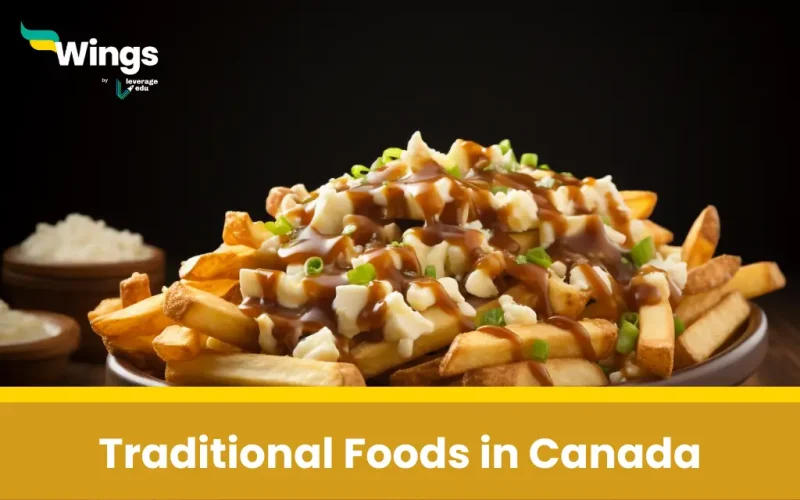Canada’s culinary landscape is a tapestry woven with the threads of diverse cultures, climates, and histories. From the traditional dishes of Indigenous peoples to the hearty fare of settlers and the global influence of modern immigration, Canada’s food story is as vast and varied as its geography. In this blog, we take a delicious journey through the top 10 traditional Canadian foods and explore the cultural significance, regional specialties, and evolving nature of the country’s cuisine.
Table of Contents
- Top 10 Traditional Foods in Canada
- 1. Poutine – Canada’s Comfort Food King
- 2. Bannock – Indigenous Bread with a Story
- 3. Tourtière – French-Canadian Meat Pie
- 4. Butter Tarts – Sweet, Gooey, and Iconic
- 5. Nanaimo Bars – No-Bake Dessert Delight
- 6. Maple Syrup – Liquid Gold of the North
- 7. Peameal Bacon – Toronto’s Signature Breakfast
- 8. Jigg’s Dinner – A Hearty Newfoundland Tradition
- 9. Bison/Buffalo Stew – A Taste of the Prairies
- 10. Arctic Char – Northern Indigenous Cuisine
- Indigenous Food Traditions: Honoring the First Nations
- Regional Flavors: How Geography Shapes Cuisine
- From Tradition to Trend: Modern Twists on Classic Dishes
- Where to Try Traditional Canadian Food?
- FAQs
Top 10 Traditional Foods in Canada
Canada’s culinary identity is deeply rooted in its history, geography, and cultural diversity. From coast to coast, traditional dishes tell the stories of Indigenous communities, early settlers, and immigrant influences. Here are 10 iconic Canadian foods that capture the true flavor of the nation.
1. Poutine – Canada’s Comfort Food King
A beloved dish that originated in Quebec, poutine is made with crispy French fries topped with cheese curds and smothered in rich gravy. Today, it has become a national icon and is served everywhere from food trucks to gourmet restaurants.
2. Bannock – Indigenous Bread with a Story
Bannock, a simple flatbread, has deep roots in Indigenous communities. It can be baked or fried and is often served with stews or eaten on its own. The recipe varies across different regions and nations.
3. Tourtière – French-Canadian Meat Pie
This savory pie filled with minced meat and spices is traditionally served during Christmas and New Year’s Eve celebrations in Quebec. It reflects the province’s French heritage and love for hearty, comforting food.
4. Butter Tarts – Sweet, Gooey, and Iconic
A quintessential Canadian dessert, butter tarts are small pastries filled with a sugary, buttery mixture. Some include raisins or nuts, but the classic version keeps it simple and sweet.
5. Nanaimo Bars – No-Bake Dessert Delight
Named after the city of Nanaimo in British Columbia, this layered dessert consists of a crumb base, custard-flavored middle, and chocolate topping. It’s rich, sweet, and requires no baking.
6. Maple Syrup – Liquid Gold of the North
No list of Canadian foods is complete without maple syrup. Made by boiling the sap of sugar maple trees, this natural sweetener is used on pancakes, in baking, and even in savory dishes.
7. Peameal Bacon – Toronto’s Signature Breakfast
Also known as “Canadian bacon,” peameal bacon is pork loin rolled in cornmeal. It is juicy, lean, and typically grilled, often served in a sandwich.
8. Jigg’s Dinner – A Hearty Newfoundland Tradition
A Sunday staple in Newfoundland, Jigg’s Dinner is a boiled meal consisting of salt beef, cabbage, root vegetables, and sometimes pease pudding. It’s a symbol of Atlantic Canadian hospitality.
9. Bison/Buffalo Stew – A Taste of the Prairies
This rich stew made from bison meat is rooted in Indigenous cuisine and Prairie tradition. High in protein and low in fat, it’s both nutritious and flavorful.
10. Arctic Char – Northern Indigenous Cuisine
Found in the cold, pristine waters of Canada’s North, Arctic char is a staple for many Indigenous communities. It can be eaten raw, smoked, or cooked in various ways.
Also Read:
Indigenous Food Traditions: Honoring the First Nations
Indigenous cuisine forms the backbone of Canadian culinary identity. It emphasizes sustainability, local ingredients, and deep respect for nature.
| Food Item | Origin/Region | Common Preparation |
| Bannock | Pan-Indigenous | Baked, fried |
| Pemmican | Plains Indigenous | Dried meat with fat/berries |
| Three Sisters Soup | Haudenosaunee | Corn, beans, squash soup |
| Wild Rice | Anishinaabe | Steamed, added to soups |
Regional Flavors: How Geography Shapes Cuisine
Canada’s cuisine varies widely from region to region, shaped by the unique climates, available ingredients, and cultural histories of each area. From coastal seafood dishes to prairie comfort foods, every region offers a distinct taste of Canadian tradition.
| Region | Signature Dish | Influences |
| Quebec | Tourtière, Poutine | French |
| British Columbia | Salmon, Nanaimo Bars | Pacific, Asian |
| The Prairies | Bison stew, Perogies | Indigenous, Eastern European |
| Atlantic Canada | Jigg’s Dinner, Lobster | Irish, English, Acadian |
| Northern Canada | Arctic Char, Seal | Inuit, First Nations |
From Tradition to Trend: Modern Twists on Classic Dishes
Traditional Canadian foods are increasingly being reimagined by chefs who blend cultural influences, modern techniques, and local ingredients. These creative twists breathe new life into classic dishes while honoring their original roots.
- Butter Chicken Poutine
- Vegan Bannock Tacos
- Maple-glazed Salmon with Asian spices
- Tourtière with lentils for a vegetarian twist
Also Read:
Where to Try Traditional Canadian Food?
- Restaurants: Au Pied de Cochon (Quebec), Bannock (Toronto), Raymonds (St. John’s)
- Festivals: Poutine Fest, Taste of the Danforth, Indigenous Food Fairs
- Markets: Granville Island (Vancouver), St. Lawrence Market (Toronto)
Traditional Canadian foods are more than just meals—they are stories, celebrations, and connections to the past. Whether you’re savoring bannock around a campfire or indulging in poutine at a street fair, each bite tells a tale of heritage and home.
So go ahead, explore, taste, and share the flavors that make Canada unique. Evaluate all study abroad options with Leverage Edu. Stay tuned with Leverage Live classes and realise your dream of studying in your country.
FAQs
While there’s no official national dish, poutine is often regarded as one of Canada’s most iconic and widely recognized traditional foods.
Not at all. Canada’s traditional foods vary greatly by region, influenced by geography, immigration, and Indigenous cultures.
Common traditional Indigenous foods include bannock, pemmican, wild rice, Arctic char, and the Three Sisters Soup (corn, beans, squash).
Yes! Many restaurants across Canada offer traditional dishes. Look for places that focus on local, seasonal, or Indigenous cuisine.
Maple syrup is a cultural symbol of Canada and is used in everything from breakfast foods and baking to savory glazes and sauces.
Absolutely. Canada is a multicultural country, and its food reflects influences from French, British, Ukrainian, Chinese, Indian, and many other cuisines.
Yes. Dishes like tourtière and bannock can be made vegan or vegetarian with ingredients like lentils, plant-based meat, or dairy substitutes.
You can find most ingredients in local grocery stores or specialty markets. Some Indigenous foods might be available at farmers’ markets or online.
Canadian bacon, or peameal bacon, is made from pork loin and is leaner than regular bacon. It’s rolled in cornmeal and usually grilled.
Try butter tarts or Nanaimo bars—both are simple to make and truly Canadian in flavor and origin.
 One app for all your study abroad needs
One app for all your study abroad needs















 60,000+ students trusted us with their dreams. Take the first step today!
60,000+ students trusted us with their dreams. Take the first step today!